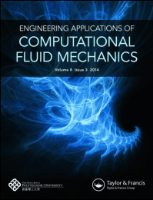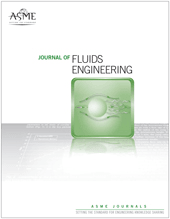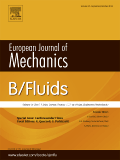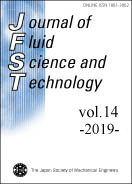
Physical Review Fluids
Scope & Guideline
Charting the Future of Fluid Dynamics Research
Introduction
Aims and Scopes
- Fluid Dynamics and Turbulence:
The journal covers a wide range of studies related to fluid dynamics, with a strong emphasis on turbulence, including its mathematical modeling, experimental investigations, and computational simulations. - Multiphase and Complex Fluids:
Research on multiphase flows, such as droplet dynamics, bubble behavior, and interactions of different fluid phases, is a significant focus, highlighting the complexities in fluid behavior under various conditions. - Non-Newtonian Fluid Mechanics:
Investigations into the behavior of non-Newtonian fluids, including viscoelastic and yield stress fluids, are prevalent, exploring their unique flow characteristics and implications in various applications. - Interfacial Phenomena:
The journal features studies on interfacial dynamics, including surfactant-laden flows, Marangoni effects, and capillary phenomena, which are crucial for understanding fluid behavior at interfaces. - Hydrodynamic Instabilities:
Research on hydrodynamic instabilities, such as Rayleigh-Taylor and Kelvin-Helmholtz instabilities, is emphasized, providing insights into transition mechanisms in fluid flows. - Machine Learning and Data-Driven Approaches:
An emerging focus includes the integration of machine learning techniques into fluid dynamics research, enhancing predictive modeling and analysis of complex fluid systems.
Trending and Emerging
- Complex Fluid Interactions:
There is an increasing focus on the interactions between different fluid phases, such as in the study of emulsions, foams, and colloidal suspensions, highlighting the significance of these systems in both natural and industrial processes. - Microfluidics and Nanoscale Flows:
Research on microfluidic systems and nanoscale fluid dynamics is gaining traction, driven by advancements in technology and the demand for precise control over fluid behavior at small scales. - Environmental Fluid Dynamics:
Investigations into fluid dynamics related to environmental phenomena, such as climate change impacts on ocean currents and atmospheric flows, are becoming more prominent, reflecting global research priorities. - Active Matter and Biological Flows:
The exploration of active matter systems, including biological flows and self-propelling particles, is emerging as a vital area of research, bridging fluid dynamics with biological applications. - Data-Driven and Machine Learning Approaches:
The integration of machine learning and data-driven methodologies into fluid dynamics research is on the rise, enhancing model predictions and enabling new insights into complex flow systems.
Declining or Waning
- Classical Fluid Mechanics:
There has been a noticeable decline in studies focusing solely on classical fluid mechanics principles, such as basic laminar flow analysis, as researchers increasingly explore complex and turbulent flow scenarios. - Simplified Models for Flow Analysis:
The reliance on overly simplified models that do not account for complex interactions in fluid dynamics has diminished, as the field moves towards more sophisticated models that capture the intricacies of real-world flows. - Empirical Studies without Theoretical Integration:
Research papers that solely rely on empirical observations without robust theoretical frameworks have become less frequent, as the community emphasizes the importance of integrating theory with experimental and computational findings.
Similar Journals

Fluids
Advancing fluid dynamics through open access research.Fluids is a leading open-access journal published by MDPI that commenced its publication in 2016, fostering a vibrant platform for the dissemination of high-quality research in the fields of Condensed Matter Physics, Fluid Flow and Transfer Processes, and Mechanical Engineering. Based in Switzerland, the journal has earned a prominent reputation, achieving a Q2 categorization in the latest 2023 rankings, indicating its significant impact within respective subject areas. Researchers and professionals will find Fluids an invaluable resource, as it not only facilitates the sharing of innovative studies but also provides open access to research findings, ensuring widespread visibility and utility. With a diversified editorial board and a commitment to exploration in fluid dynamics and related applications, Fluids aims to advance knowledge, foster collaboration, and inspire future research endeavors among its readership. As the journal converges into new frontiers from 2016 to 2024, it continues to be a pivotal reference for scholars and practitioners alike.

Engineering Applications of Computational Fluid Mechanics
Pioneering Solutions in Fluid Mechanics ApplicationsEngineering Applications of Computational Fluid Mechanics is an esteemed journal published by Taylor & Francis Ltd that serves as a vital resource for researchers, professionals, and students in the field of fluid mechanics and its computational applications. With an ISSN of 1994-2060 and an E-ISSN of 1997-003X, this journal has established its reputation through its rigorous peer-review process and commitment to Open Access since 2015, facilitating widespread dissemination of cutting-edge research. Based in the United Kingdom, the journal is indexed in leading databases and has achieved a significant impact in its categories, ranking in the top quartile (Q1) for both Computer Science (miscellaneous) and Modeling and Simulation as of 2023. Notably, its Scopus rankings place it in the top 4% of Mathematics/modeling and simulation, highlighting its importance in advancing knowledge and innovation within the discipline. The journal invites contributions that explore both theoretical and practical aspects of computational fluid dynamics, fostering collaboration and intellectual growth within the community.

FDMP-Fluid Dynamics & Materials Processing
Fostering Collaboration for a Dynamic Future in MaterialsFDMP-Fluid Dynamics & Materials Processing, published by TECH SCIENCE PRESS, stands as a significant contribution to the field of materials science, specifically focusing on the intricate relationships between fluid dynamics and material processing. With an ISSN of 1555-256X and an E-ISSN of 1555-2578, this journal offers an open-access platform where researchers can disseminate their work broadly, promoting collaboration and innovation among professionals and students alike. Established in 2007 and continuously evolving through to 2024, the journal is classified in the Q4 category of materials science, ranking at #347 out of 463 in the Scopus database, signifying its niche yet crucial role in the academic community. By focusing on the dynamic interplay between fluid behavior and material properties, FDMP addresses contemporary challenges and advances in material processing techniques. The journal plays a pivotal role for academics and industry professionals seeking to push the boundaries of knowledge and application in materials science.

JOURNAL OF FLUIDS ENGINEERING-TRANSACTIONS OF THE ASME
Exploring the Depths of Fluid DynamicsJOURNAL OF FLUIDS ENGINEERING-TRANSACTIONS OF THE ASME, published by the renowned American Society of Mechanical Engineers (ASME), stands as a pivotal platform for disseminating cutting-edge research in the field of mechanical engineering, specifically focusing on fluid mechanics and its diverse applications. With an established history dating back to 1897, this journal features research that pushes the boundaries of knowledge and technology in areas such as fluid dynamics, thermal engineering, and hydrodynamics. Although it is not an open-access journal, it maintains rigorous peer-review standards, ensuring the publication of high-quality scholarly articles that contribute to the academic and professional community. In the latest rankings, it holds a respectable position within the Q2 category of mechanical engineering journals, reflecting its significant impact, as evidenced by its Scopus rank of #204 out of 672, placing it in the 69th percentile. Researchers, professionals, and students alike will find this journal to be a vital resource for the latest developments and innovative insights in fluids engineering.

THEORETICAL AND COMPUTATIONAL FLUID DYNAMICS
Innovating Fluid Mechanics Through Rigorous Research.THEORETICAL AND COMPUTATIONAL FLUID DYNAMICS, published by SPRINGER, stands at the forefront of scientific discourse in the fields of fluid mechanics and computational methods. With an impressive impact factor reflecting its significance and reach, this journal has consistently maintained a Q1 ranking across multiple categories, including Computational Mechanics and Condensed Matter Physics as of 2023. Covering a rich scope of theoretical research and computational analysis, it aims to advance the understanding of fluid flow and transfer processes, making it an essential resource for researchers, professionals, and students alike. The journal, with its historical archive extending from 1989 to 2024, not only contributes to foundational theories but also integrates applied research and emerging computational techniques, thus facilitating innovation within the discipline. As a result, THEORETICAL AND COMPUTATIONAL FLUID DYNAMICS serves as a crucial platform for disseminating impactful findings that shape future advancements in fluid dynamics research.

COMPUTERS & FLUIDS
Advancing the Frontiers of Computational Fluid DynamicsCOMPUTERS & FLUIDS, published by PERGAMON-ELSEVIER SCIENCE LTD, is a premier journal in the fields of Computer Science and Engineering, with a distinguished history dating back to 1973. Its Q1 ranking in both Computer Science (Miscellaneous) and Engineering (Miscellaneous) illustrates its high impact and relevance, being positioned among the top tier of scientific publications. With a robust focus on the intersection of computational methods and fluid dynamics, this journal serves as a vital platform for researchers, professionals, and students dedicated to advancing knowledge and technology within these domains. Although it is not an open-access journal, its articles are accessible through various academic institutions and libraries, ensuring that vital research reaches its intended audience. Readers can explore innovative methodologies and applications, reinforcing the journal's commitment to enhancing the understanding of fluid mechanics through cutting-edge computational approaches. For more details, visit the official website of COMPUTERS & FLUIDS to stay abreast of the latest research advancements.

EUROPEAN JOURNAL OF MECHANICS B-FLUIDS
Unveiling the Mysteries of Fluid BehaviorThe EUROPEAN JOURNAL OF MECHANICS B-FLUIDS, published by Elsevier, is a prominent journal in the field of fluid mechanics, addressing the theoretical and experimental aspects of fluid behavior. Since its inception in 1990, this journal has consistently fostered a robust academic dialogue, maintaining a significant impact evidenced by its Q2 ranking in both Mathematical Physics and Physics and Astronomy categories as of 2023, placing it among the top publications in these disciplines. Researchers and professionals focusing on fluid dynamics will find a wealth of knowledge in its articles, which span broad topics pertinent to real-world applications as well as fundamental theories. While the journal is not open access, it offers critical insights that shape ongoing studies in fluid mechanics, making it an invaluable resource for anyone looking to deepen their understanding of the field. Located in the innovative environment of Amsterdam, Netherlands, the journal serves as a nexus for cutting-edge research and collaboration globally.

Journal of Fluid Science and Technology
Elevating Understanding of Fluid Transfer ProcessesThe Journal of Fluid Science and Technology, published by the Japan Society of Mechanical Engineers, serves as a pivotal platform for the dissemination of cutting-edge research in the fields of fluid mechanics and mechanical engineering. With an ISSN of 1880-5558, this Open Access journal has been dedicated to advancing the understanding of fluid flow and transfer processes since its establishment. As of 2023, it holds a significant position with a Q3 quartile ranking in both Fluid Flow and Transfer Processes and Mechanical Engineering categories. Researchers and practitioners are encouraged to explore the journal’s extensive collection of articles, contributing to the body of knowledge that impacts various practical applications in engineering and technology. The journal, which has established a reputation for quality amidst a competitive landscape, further fosters international collaboration and education by providing unrestricted access to its content. For professionals and students alike, the Journal of Fluid Science and Technology represents an invaluable resource for the latest findings and innovations in fluid dynamics and mechanical systems.

INTERNATIONAL JOURNAL FOR NUMERICAL METHODS IN FLUIDS
Navigating the Complexities of Fluid Flow with PrecisionINTERNATIONAL JOURNAL FOR NUMERICAL METHODS IN FLUIDS, published by Wiley, has established itself as a leading platform for cutting-edge research in the fields of applied mathematics, computational mechanics, computer science applications, and mechanical engineering. With its ISSN 0271-2091 and E-ISSN 1097-0363, this journal is committed to disseminating high-quality, peer-reviewed articles that contribute to the advancement of numerical methodologies in fluid dynamics. Boasting a commendable 2023 impact factor that places it in the second quartile across multiple relevant categories, it provides insights into significant research dimensions that engage an audience of researchers, professionals, and students keen on the computational challenges of fluid flow. The journal's broad scope encompasses foundational and applied research, encouraging the exploration of new numerical techniques and algorithms. As an invaluable resource based in the United Kingdom, INTERNATIONAL JOURNAL FOR NUMERICAL METHODS IN FLUIDS remains dedicated to providing insights and fostering innovation in its domain, with a consistent publication history spanning from 1981 to 2024.

Experimental and Computational Multiphase Flow
Transforming Understanding of Complex Fluid PhenomenaExperimental and Computational Multiphase Flow, published by SpringerNature, is a prestigious academic journal that critically examines advancements in the field of fluid dynamics, with a specialized focus on multiphase flow phenomena. Since its inception in 2019, the journal has established a remarkable reputation, attaining Q1 status in Fluid Flow and Transfer Processes as well as Mechanical Engineering according to the 2023 category quartiles, reflecting its high impact and relevance in these domains. With Scopus rankings placing it among the top 15 journals in both Chemical Engineering and Nuclear Energy and Engineering, Experimental and Computational Multiphase Flow is an essential resource for researchers, professionals, and students engaged in cutting-edge studies and applications. Although it operates on a subscription model, the journal remains dedicated to disseminating high-quality research and fostering a deeper understanding of complex fluid interactions across various scientific disciplines. By prioritizing innovative methodologies and interdisciplinary collaborations, the journal aims to significantly contribute to the ongoing evolution of multiphase flow research, recognizing its critical importance in engineering and energy sectors.